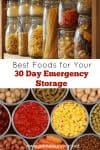[ad_1]
By now, you hopefully know that you need emergency food storage to be prepared for disasters like hurricanes, earthquakes, EMP, or even personal disasters like losing a job.
If you are a beginner at prepping, start with our 72-hour kit checklist. Once that is covered, move on to 30-day emergency food storage.
Thirty days of food is the absolute minimum you should stockpile for emergency preparedness. You’ll also need 30 days’ worth of water.
Read: how much water to stockpile
Getting emergency food for 30 days may seem simple enough, but don’t just go out and buy a zillion cans of soup, boxes of crackers, and bulk grains.
Disaster prepping should always be done with a plan!
If you don’t plan what to get and how to use it, you could end up with many unusable food items in the aftermath of a disaster.
The Two Types of Emergency Foods to Store
There are many types of survival foods to stockpile. For your 30-day emergency food storage, we can break them down into two types:
- Foods that don’t require cooking
- Foods that require cooking
To be fully prepared, you should combine both types of emergency foods.
Emergency Foods That Don’t Require Cooking
You can find lots of ready-to-eat emergency foods in your local supermarket. The benefit of storing these foods is that they are easy. Picture your family sitting in your basement eating granola bars and soup straight out of the can as a hurricane rages around you.
There is no need to cook, prepare, or even clean plates. You just pop open the packaging and start to eat.
Another reason you need to have ready-to-eat emergency foods is that it isn’t always safe to cook after a disaster. For example, you should never have an open flame after an earthquake. This is because gas lines break, and an open flame could result in an explosion. So, if this is the case, you would want foods that don’t require cooking.
Examples of Emergency Foods That Don’t Require Cooking
Emergency Foods that Require Cooking
In theory, you could stockpile just ready-to-eat foods for your 30-day emergency food supply. However, it will probably get boring eating all those canned and packaged foods after a few days (I’ve run disaster scenario drills before and can attest to how boring it gets to eat just packaged food!).
Ready-to-eat emergency foods also tend to be lacking nutritiously. It might be okay to live off granola bars for a day or two during a blackout, but all that sugar, fat, and sodium will make you feel like crap in a longer-term disaster situation.
When you cook food, it is more nutritious and will give you the energy you need to stay healthy and alert in the disaster aftermath.
Finally, you’ll want some emergency foods which require cooking because they taste better. The taste shouldn’t be a priority for disaster preparedness, but having tasty food can go a long way in alleviating the stress which comes with emergencies. Even the act of cooking might be a welcome distraction from the disaster.
Examples of Emergency Foods that Do Require Cooking
- Pasta
- Rice, barley, and other grains
- Dry beans and legumes
- Packets of instant soup
- Instant mashed potatoes
- Meals in a box
Other Items for Your 30-Day Emergency Food Storage
- Salt, herbs, spices, and seasoning packets: Eating plain pasta, canned veggies, etc., can be boring. A bit of seasoning can go a long way to making it taste better (and thus making the disaster aftermath less stressful).
- Powdered drink mixes: Preferably ones that have vitamins in them.
- A can opener: Make sure it is a manual can opener, not an electric one! Read how to open a can without a can opener.
- Paper plates and plastic utensils: You don’t want to waste precious water on washing dishes, so have enough disposable plates and utensils stockpiled.
- Off-grid cooking method plus fuel: If the utilities go down after the disaster, how will you prepare your food? Ensure you have an off-grid cooking method and enough fuel to last you through the month.
Items NOT on the List
You’ll notice I didn’t include certain items like wheat, grains, or flour in the 30-day emergency food storage.
It might seem logical to stockpile wheat grains for emergencies so you could make bread.
But let me ask you, do you know how to grind wheat into flour?
And, if you do, how will you make bread if you don’t have any yeast?
You’ll also need baking soda, baking powder, egg substitutes, and other basics to utilize your flour.
As for stockpiling ready-milled flour, it can be a disaster if you don’t store it properly. You’ll likely end up with a moth or mold infestation if you don’t utilize vacuum-sealed mylar bags.
Read about pantry pests and how to avoid them.
Items like wheat and flour are fine to stockpile for your long-term supply. But, when you are just starting, stick to the essentials. Once you’ve mastered the 30-day stockpile, you can move on to the more advanced skill of long-term food storage.
Have you built your 30-day emergency food storage yet? Let us know how it is going in the comments.
[ad_2]
Source link
